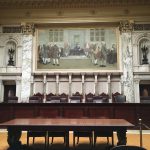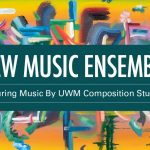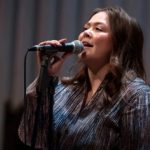Tchaikovsky’s Violin Concerto sings in Takezawa’s hands
Tchaikovsky’s Violin Concerto deserves its reputation as a difficult piece to play. The complex passages can tempt soloists to focus on technique, to demonstrate that they can find every note. Kyoto Takezawa brought comprehension to the work and drove through the complexity to treasure the beauty in the music. Her style was clear, radiant and always lyrical. Her Guarneri del , Gesu violin produced the deep, rich tones of a viola in lyric passages and, in Takezawa’s hands, the most stratospheric sounds with tender clarity.
Planting her feet to brace for her opening bars, Takezawa committed herself to the work. As the melody rose, her violin pointed into the sky. When the music moved from quiet to a crescendo, she knelt slightly then slowly rose again. No matter how challenging a passage, a song was ever present.
When Takezawa shared melodies with the orchestra, she turned to focus on Edo de Waart and the MSO to ensure complete coordination. Not that the orchestra was noticed much. Edo de Waart restrained them to a supporting role. All eyes were on Takezawa.
In the Canzonetta, she brought out Tchaikovsky’s idea of an Italian aria – richly romantic with broad emotive lines. She made more than a virtuoso game of the speedy final movement. Takezawa understood the structure, the ebb and flow of a development building in steps toward a dramatic conclusion. Bold rhythmic strokes defined key turning points. Contemplative passages gave up their beauty – particularly one section played entirely in upper register. When the music accelerated, the bow danced across the strings and skated to ever faster speeds.
Throughout the concerto, Takezawa shaped the sound and brought out the soul.
_________________________________________________________________
On an ordinary weekend, Ralph Vaughan Williams’ choral masterpiece, A Sea Symphony, would be the headline.
Along the way, Vaughan Williams touches on somewhat contradictory themes. Edo de Waart took the work as it was written, shaping each emotional high to its own objective.
The symphony begins with a trumpet fanfare and an explosive choral sound. The sea waves rise and fall to –
Behold the sea itself
And on its limitless breast, the ships
See, where their white sails, bellying in the wind, speckle the green and blue.Colors as bright as a Turner seascape shine in this section.
The stirrings of internationalism are celebrated in the call to honor those who died at sea –
Flaunt out O sea, your separate flags of nations
…But …reserve for yourself and for the soul of man one flag above the rest
…A pennant universal.Soprano Christine Goerke and Baritone Hugh Russell carried the stanzas. Their full voices soared over orchestra and chorus.
The ethereal moods of the sea under a starlit sky are delivered as tone poem sound scape in the second movement nocturne –
As I watch the bright stars at night, I think a thought of the clef of the universe and of the future
A vast similitude interlocks all
In the scherzo, the British nationalist fever of this island nation comes through the music, although with less help from Whitman.
Where the great vessel sailing and tacking displace the surface
…The wake of the sea ship after she passes.Vaughan Williams introduces his most stridently English motifs – seemingly celebrating the power of the British empire.
The symphony closes with the challenges of adventure delivered as tributes to the bravery of explorers and the transcendent need of man to explore –
Joyous we too launch out on trackless seas
…For we are bound to go where mariner has yet dared to go [Trekkies take note]
…O farther, farther, farther still.By this point, the transcendent is marked in reverent quiet tones to dramatically close the work.
This is not a simple symphony, but a complex and multi-themed work. The text counts, the lyrics are extraordinary and carry emotional content; supertitles would have been helpful. Even well articulated choral singing is not always intelligible over a full orchestra.
The presentation was inspired. The Milwaukee Symphony Chorus was designed to sail this symphony, whether soaring over the orchestra or delivering the transcendent opening of the fourth movement. The soloists, Goerke and Russell, have the vocal power to contribute dramatic weight, even during sections with full chorus and orchestra.
The orchestra, under de Waart, delivered the ensemble color required of a tone poem dedicated to the sea. The waves heaved and crashed, storms rose and eddies swirled through the orchestra. Appropriately, de Waart pulled back on the sound sculpting when the poetry was more universal.
The Milwaukee Symphony management scheduled its own Black Friday special on this slow holiday weekend, and gave 1,002 tickets. What better concert to convince a new audience to love the treasure that is the MSO.?
The final concert begins at 8:00 P.M. (pre-talk at 7:00), Saturday, Nov. 27, at Marcus Center Uihlein Hall, 929 N. Water St. Tickets are $25-$95 at the MSO ticket line, 414-291-7605; at the Marcus Center box office, 414-273-7206.






















